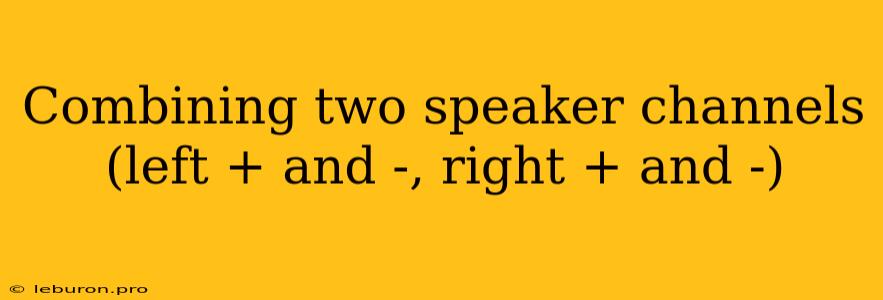The world of audio engineering is filled with intriguing possibilities, allowing for the creation of immersive soundscapes and manipulating sound in ways that can enhance the listening experience. One such technique, often employed in professional audio production, involves the combining of two speaker channels, specifically the left (+) and right (-) channels. This process, known as channel combination, offers a unique approach to audio manipulation, enabling the creation of intriguing effects and expanding the creative potential of audio production. In this article, we delve into the intricacies of combining two speaker channels by exploring the fundamental principles, practical applications, and the creative potential that lies within this audio technique.
Understanding the Fundamentals of Channel Combination
The concept of combining two speaker channels relies on the manipulation of audio signals to create a desired effect. This involves combining the left (+) and right (-) channels of a stereo audio source to achieve specific sonic outcomes. Essentially, it's about taking the individual audio information present in each channel and merging them into a single output. This can be achieved using various methods, including:
- Summing: This involves adding the signals of the left and right channels together, resulting in a mono signal.
- Panning: This involves adjusting the balance between the left and right channels to create the illusion of sound moving across the stereo field.
- Crossover: This involves splitting the audio signal into different frequency ranges and directing them to specific channels, often used for creating separate left and right speakers for specific frequency ranges.
Applications of Combining Two Speaker Channels
Combining two speaker channels holds a diverse range of applications, each tailored to achieve a specific audio effect or enhancement. Some notable applications include:
1. Creating Mono Signals
One of the most common applications of combining two speaker channels is to create a mono signal from a stereo source. This is often used for compatibility reasons, as many older audio devices and systems only support mono audio. By summing the left and right channels together, a single mono signal is generated. This can be achieved through various means, including:
- Mixing consoles: Many mixing consoles feature mono outputs that allow you to sum the left and right channels into a single output.
- Audio editing software: Most digital audio workstations (DAWs) provide tools for summing channels, enabling you to create a mono version of your audio.
- Hardware converters: Dedicated mono converters can be used to convert stereo audio signals into mono signals.
2. Enhancing the Center Image
The center image is the perceived location of the audio signal directly in front of the listener. Combining two speaker channels can be used to enhance the center image, making it more prominent and powerful. This can be achieved by:
- Adjusting the pan position: Moving the pan position closer to the center can make the center image more defined.
- Adding a dedicated center channel: By adding a dedicated center channel, you can create a stronger center image, often used for voice-overs, dialogue, and instruments intended to be prominent in the center of the mix.
3. Creating Special Effects
Combining two speaker channels can also be used to create unique and interesting special effects. By manipulating the phase and amplitude of the left and right channels, you can create:
- Phase cancellation: This effect occurs when two signals with opposing phases are combined, resulting in a reduction of the overall volume. Phase cancellation can be used to create specific sonic textures and effects.
- Chorus: This effect can be achieved by combining two slightly delayed and detuned versions of the original signal, creating a thicker and more spacious sound.
- Flanger: This effect is created by delaying and mixing the left and right channels, resulting in a swirling, ethereal sound.
Creative Potential of Channel Combination
Beyond its practical applications, combining two speaker channels unlocks a world of creative possibilities in audio production. By experimenting with different combinations and techniques, you can:
- Add dimension and depth to your mixes: By creating a wider stereo image or enhancing the center image, you can make your mixes feel more spacious and engaging.
- Create unique and interesting soundscapes: Through creative manipulation of phase, amplitude, and delay, you can achieve unique soundscapes that would be impossible to create with traditional audio production techniques.
- Enhance the overall impact of your music: By strategically combining channels, you can create a more powerful and impactful listening experience.
Conclusion
Combining two speaker channels is a valuable tool in the audio engineer's arsenal, offering practical solutions and endless creative possibilities. By understanding the fundamentals of this technique, you can effectively manipulate audio signals to achieve specific effects, enhance the listening experience, and explore new sonic landscapes. Whether you're aiming for a clean mono signal, a powerful center image, or unique sound design elements, the ability to combine two speaker channels allows you to push the boundaries of audio creativity and achieve your desired sonic outcomes.
